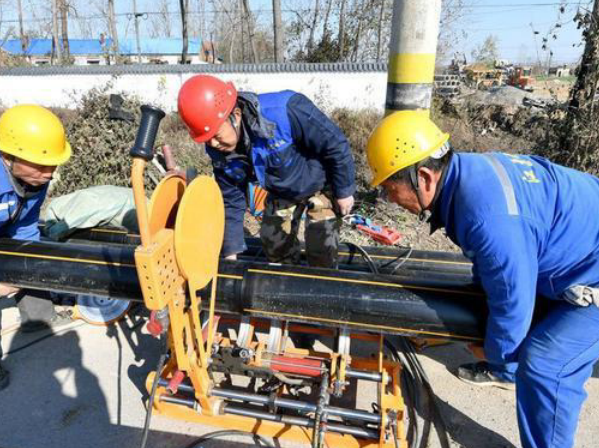With the development of the scale of gas use, some suburbs or rural areas have also begun to build gas pipelines. Rural laying is mainly direct burial laying. Direct burial laying does not require masonry trenches, earthwork, less civil engineering, prefabricated pipelines, less on-site installation workload, fast construction progress, saving pipeline network investment costs, and small area.
A) It is difficult to lay gas pipelines in rural areas
1. Pipeline perforation leakage problem
The main problem with pipe perforation leaks is the welding of welded joints. Since the welded joint not only bears the pressure of the pipeline, but also bears the pressure of the underground soil layer, road vehicle load, land subsidence, etc., if the weld seam is defective, it will reduce the strength of the pipeline. Once the external force is too large, it will cause the pipeline to break and cause the pipeline to perforate and leak.
Therefore, the welding of the interface needs to be carried out according to the pressure requirements. After the welding is completed, various detection methods need to be adopted to identify the reliability of the interface.

2. Corrosion and leakage of pipelines
Buried steel pipes are prone to chemical corrosion. In the early days, due to technical limitations, only petroleum asphalt glass cloth was used as the anti-corrosion material for external anti-corrosion, which has the disadvantages of high water absorption, fast aging, poor adhesion, and low mechanical strength. The disadvantages of this anti-corrosion layer are mainly reflected in two aspects:
1) The anti-corrosion layer is damaged. When there is a problem with the petroleum asphalt glass fiber anti-corrosion layer, the steel pipe will be damaged, corroded, and eventually lead to perforation and leakage;
2) Water seepage in the anti-corrosion layer. The surface of petroleum asphalt glass fiber is very complete, but it is separated from the steel pipe, and groundwater seeps in through the anti-corrosion layer, making the steel pipe wrapped in water rusty. Steel pipes also corrode and leak over time.
B) Take countermeasures against difficulties in laying gas pipelines in rural areas
1. Countermeasures against pipeline perforation leakage
Pipe puncture leaks are very serious among plumbing problems. Once handled improperly, it will not only affect the normal use of villagers, but also cause economic losses to gas companies. The hidden dangers found in the welding process are as follows:
a) Common interface. The interface has no gaps and no grooves, but the inner weld meat is not full and not completely welded, and it is easy to crack under pressure;
b) Saddle tee interface. The welding around the saddle tee joint is not thorough and the welding layer is thin, resulting in uneven weld width and poor fusion.
The main reason is that the diameter of the newly opened hole is too large, the new connecting pipe is inserted into the round hole, and the gap is too large, so the metal rod can only be inserted in the annular seam. Therefore, corresponding leak-proof measures must be taken:
1) Selection of steel pipes.
Seamless pipes can be used to bury pipelines and weld joints to avoid leakage caused by weak joint connections;
2) Pipe direction. In the choice of pipeline direction, try to choose places that are inaccessible or rarely touched in rural life, such as Fangshan, corners, etc., which need to be marked to facilitate the development of maintenance work;
3) Material inspection. During the pipeline laying process, a certain intensity of air tightness test should be carried out. On the premise of ensuring that all materials meet various indicators, the pipeline should be closed to ensure the safe and effective process of gas pipeline laying.
2. Countermeasures for pipeline corrosion and leakage
Corrosion air leaks are common around homes. Because some farmers plant gardens around their houses, turning the soil and fertilizing during the planting process will have a certain impact on the soil, which will corrode the gas pipeline and cause the gas pipeline to leak. The problem of corrosion and air leakage can be solved by repairing the anti-corrosion layer.
For example, buried steel pipes were laid in a village. At that time, it used petroleum asphalt glass cloth for anticorrosion. When the villagers found that the gas was insufficient during use, they reported it to the gas company. The maintenance personnel came to the village to check the problem of the gas pipeline, dug out a part of the gas pipeline, and found that there were pores and folds between the anti-corrosion layer and the pipe wall, and some parts of the steel pipe had entered the corrosion period, and immediately thought of three maintenance strategies:
1) Overlay protection. Covering metallic or non-metallic materials that have better corrosion resistance than buried pipelines requires protection of the material surface. Since the pipeline has been laid, the maintenance personnel have given up this way;
2) Use corrosion inhibitors. Corrosion inhibitor protection is a method of protecting metals by adding a small amount of substances that can prevent or slow down the corrosion of metals. Corrosion inhibitors have the characteristics of low cost, fast effect, and convenient use, but they also have disadvantages such as polluting the environment, so maintenance personnel have also given up this plan;
3) The principle of electrochemical corrosion. Maintenance personnel use the principle of electrochemical corrosion: using metals whose activity exceeds that of buried equipment, oxygen reacts with highly active metals, and solves the problem by adding an active metal protective layer.


